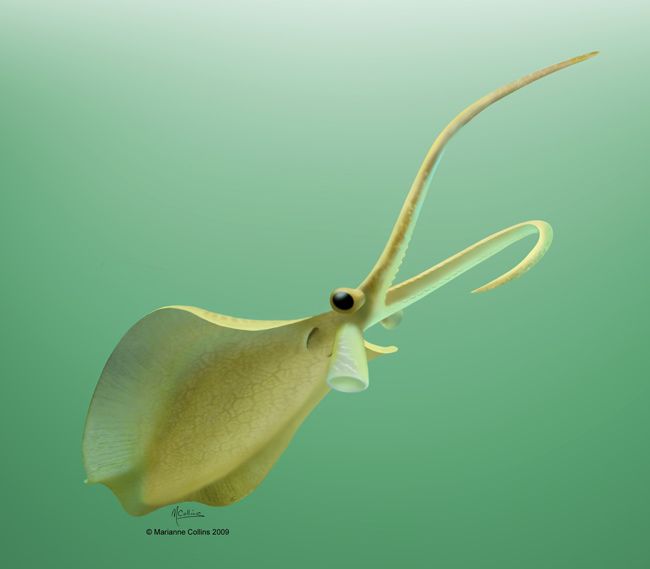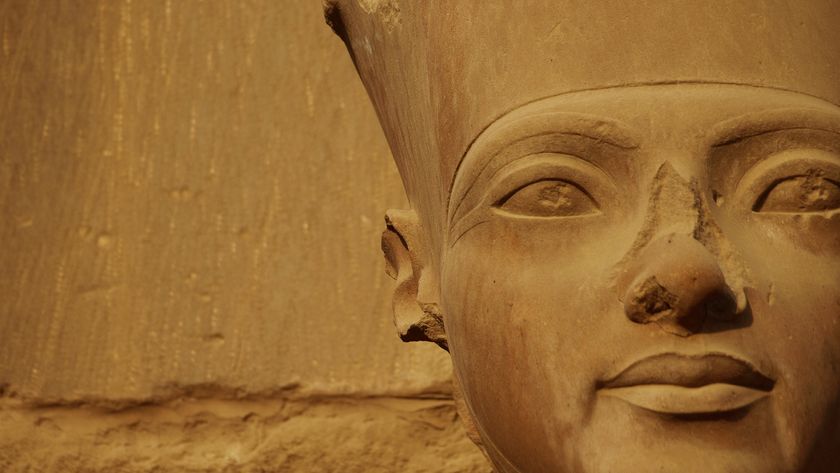
Mysterious Bug-Eyed Ancient Creature Discovered

It's not the mythical kraken, but an ancient creature belonging to the largest, nimblest and probably smartest group of invertebrates has jumped out of the fossil record with a different identity than previously thought. That finding restructures a branch on the evolutionary tree.
The tiny mysterious fossil of Nectocaris pteryx — previously described as a shrimp with a chordate tail — is neither a shrimp (an arthropod) nor a chordate (vertebrates and their nearest relatives), but a mollusk, according to a new study detailed in the May 27 issue of the journal Nature.
Don't picture boring mollusks, such as snails, slugs and mussels, however. Think cuttlefish, squid, and octopi — and yes, even the kraken — which are cephalopods, a member of the mollusk phylum. The 505 million-year-old creature is the oldest recorded cephalopod by about 10 to 15 million years and provides clues about modern cephalopod evolution.
Nectocaris is a miniscule cephalopod at only 2 to 3 inches (5 to 7 centimeters) long. It looks like a cartoon character from a Pixar movie with its bulging eyes and funnel-shaped nozzle that squirts water where one would expect a nose.
Researchers acquired 91 new specimens of Nectocaris from the well-known fossil hunters' playground called the Burgess Shale, which contains fossil beds surrounded by mountains in British Columbia, Canada. The Burgess Shale is filled with pristine soft-bodied animal fossils — those ancient animals without a shell that have largely eluded paleontologists because they rarely fossilize — from the Cambrian period between 542 million and 490 million years ago.
Scientists pulled the Nectocaris specimens, originally acquired in the 1980s, off the shelves of the Royal Ontario Museum and completed the most detailed analysis of this species, courtesy of several complete fossils of side-on and top-down views of the creature.
Nectocaris is most likely a stem group cephalopod, meaning it broke off from the evolutionary tree before the last common ancestor of modern cephalopods, said paleontology graduate student Martin Smith of the University of Toronto, who led the study.
Sign up for the Live Science daily newsletter now
Get the world’s most fascinating discoveries delivered straight to your inbox.
The most striking structure of Nectocaris is the large funnel-shaped nozzle that swivels and expels water to propel the body at high speeds.
"It's a way of turning on their afterburner," said paleontologist Stefan Bengtson of the Swedish Museum of Natural History, who was not involved in the study.
The unusually preserved eyes of Nectocaris are known as camera-type eyes, like those found on squids. The large eyes and nozzle suggest that Nectocaris must have had a rather large brain to power these features.
Cephalopods are active predators with the most advanced nervous system known among invertebrates. They use camouflage, change their shape, surface pattern, texture, and color and are "extremely agile in the way they react to their environment. They really are masters of camouflage," Bengston told LiveScience.
Cephalopods are unique in developing jet propulsion, and the discovery of the nozzle on Nectocaris suggests jet propulsion evolved before shells in modern cephalopods. While most modern cephalopods are shell-less, the fossil record is skewed toward hard-shelled cephalopods, because their tough shells make them more likely to be preserved.
Nectocaris has other cephalopod features, such as a pair of flexible tentacles near the mouth, gills, and a body perfect for swimming. However, it is missing a number of modern cephalopod traits, such as a ring of tentacles around the mouth, a beak, a toothed tongue (known as a radula), and an ink sack or suckers.
- Our 10 Favorite Monsters
- 25 Amazing Ancient Beasts
- Image Gallery: Small Sea Monsters













